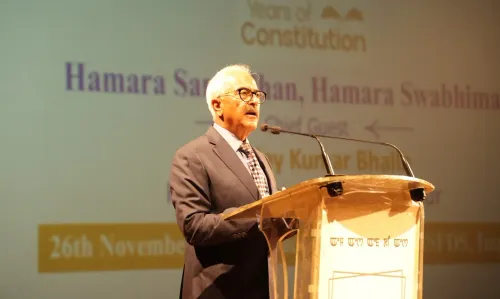Is FM Sitharaman Going to Propose a GST Rate Overhaul on Aug 20?

Synopsis
Key Takeaways
- Finance Minister Nirmala Sitharaman to propose GST rate overhaul.
- Group of Ministers meeting on August 20-21.
- Transition to a simplified two-slab GST structure.
- Potential 0.5-0.6% GDP stimulus.
- New rates: 5% for essentials, 18% standard.
New Delhi, Aug 19 (NationPress) Finance Minister Nirmala Sitharaman is poised to unveil the government's plan aimed at revising the goods-and-services-tax (GST) rates during a two-day meeting with a Group of Ministers (GoM) starting on August 20 in the national capital.
The GoM, led by Bihar Deputy Chief Minister Samrat Choudhary, is scheduled to convene at Vigyan Bhawan on August 20 and 21, kicking off the discussions at 12 noon, according to reports.
A six-member state panel is anticipated to focus on the Union government's strategy to transition to a more straightforward two-slab GST structure.
The GST Council is expected to convene on September 18-19 to make a definitive decision regarding the proposal.
This proposed GST revamp emerges at a time when global investment firm Morgan Stanley has identified tax reforms, alongside various policy actions, as vital for bolstering India’s consumption narrative.
Morgan Stanley's recent report indicates that a potential overhaul of the GST rates, in conjunction with income tax reductions, relaxed policies, increasing job opportunities, and rising real wages, could significantly enhance the outlook for domestic demand.
The report also highlighted that while there may be a temporary decline in volume growth as consumers await clarification on the new tax rates, demand is projected to rebound once the revised GST system is implemented.
Lower indirect taxes are expected to enhance affordability for low-income families, as these taxes are inherently regressive.
The analysis suggested that the proposed GST overhaul could serve as a stimulus equivalent to approximately 0.5-0.6 percent of GDP annually, with the potential to boost GDP growth by 50-70 basis points.
It also anticipated a possible reduction of 40 basis points in CPI inflation, although both the central and state governments might encounter short-term revenue challenges due to decreased collections.
The government’s proposal aligns with Prime Minister Narendra Modi’s Independence Day declaration of “next-gen GST reforms before Diwali,” resting on three pillars: structural reforms, rate rationalization, and ease of living. The new framework proposes two main GST rates — 5 percent for essential goods and 18 percent as the standard rate.









